
The wonderful Messier Object M45 (The Seven Sisters, Pleiades). It's famous as the @Subaru_corp logo ("Subaru" is the Japanese name for this cluster!). It is the closest Messier Object to Earth! The bright stars lighten up the gas remanents of their formation.
#astrophotography
#astrophotography

[/1]
I've revisited this object after a year of #astrophotography practice, and what a difference a year makes! The left is in Dec 2020 with my DSLR setup, on a tripod outside of Vancouver. The right is with my setup on my balcony in Downtown Vancouver.
[/2]
[/2]

On top of being able to more of the nebula, we can see a lot more detail within the nebula; the striated gas is just stunning!
[/3]
[/3]

Pleiades is an amazing object. It's "only" 450 light years away & is visible in most night skies (only the strongest light pollution hides it). It's earliest depiction is in 1600 BCE by the Unetice culture. Galileo was the 1st to see it through a telescope, & he sketched it here. 



[/4]
Pleiades has made appearances in Homer's Iliad, the Bible, Sioux oral tradition, and the Qur'an. It's known as the "Makali'l" in Hawaiian, and are part of the Australian Indigenous traditional stories.
[/5]
[/5]

The nine brightest stars are named after Greek Mythology's Pleione and Atlas and their Seven Daughters: Sterope, Merope, Electra, Maia, Taygeta, Celaeno, and Alcyone. I've labelled the stars here.
[/6]
[/6]

@NASAHubble captured an amazing photo by zooming into Merope, and just to the top right you can see the light of the star. Underneath it, an amazing nebula lit up by Merope herself.
[/fin]
[/fin]
• • •
Missing some Tweet in this thread? You can try to
force a refresh













